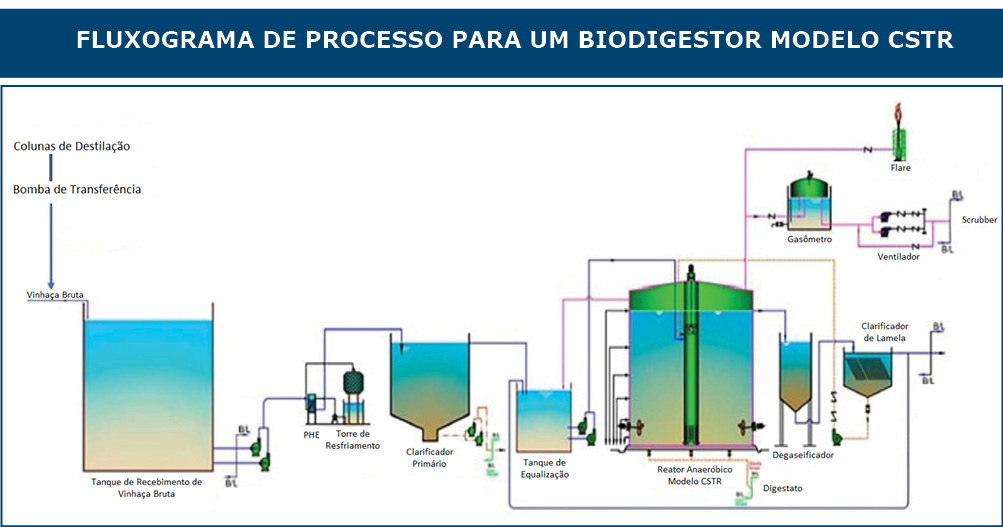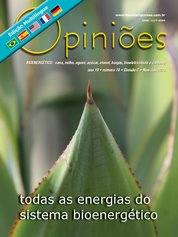José Campanari Neto
Director of MCE Engineering and Systems
OpAA74
An energetic vegetable par excellence
In the last 10 years, we have seen several advances in the thermal area, among which we can highlight:
Boilers with fluidized bed, enabling the controlled combustion of bagasse with 65% humidity; Distilleries operating under vacuum, reducing the specific consumption of steam for distillation from 3.5 kilograms of steam per liter of alcohol to 1.3 kilograms of steam per liter of alcohol (hydrated); 4.5 kilograms of steam per liter of alcohol, for 1.8 kilograms of steam per liter of alcohol (anhydrous);
Production of Biogas from vinasse, at an approximate rate of 10 cubic meters per cubic meter of vinasse; and 5.8 normal cubic meters per cubic meter of biomethane vinasse , providing several application alternatives, including replacement of diesel oil and direct sale of biomethane. Production of electrolytic ammonia, via electricity surplus, reaching self-sufficiency in nitrogen fertilizer, as an alternative to the direct commercialization of electric energy, in case the value of the megawatt hour is not feasible.
With the arrival of boilers equipped to burn biomass in a fluidized bed, there was a huge advance in technology, allowing the burning of bagasse with a moisture content of up to 65%, which allows stable operation, even in rainy periods, returning the bagasse stored in the patio. open. Not to mention the high thermal efficiency of the boiler, provided by burning with very low excess air (20%) and practically zero unburned losses, resulting in a higher specific production of steam, in terms of kilogram of steam per kilogram of bagasse.
With distilleries designed to operate under vacuum, there is a significant reduction in steam consumption in the distillation process; Let's see, if we compare a unit producing 80 liters of alcohol per ton of cane, we would have a reduction in the consumption of process steam of 176 kilograms of steam per ton of cane for the production of hydrated alcohol and 216 kilograms of steam per ton of cane for production of anhydrous alcohol. Later this year, in Quirinópolis in Goiás, we will be able to see a unit with the capacity to produce 850 cubic meters of ethanol per day in operation.
It is important to note that most sugar and ethanol plants distill using vegetable steam 1 and, therefore, the simple implantation of vacuum columns would not bring immediate benefit, if the evaporation process and the juice treatment were not adjusted simultaneously, and, in this case, there would be a steam left into the atmosphere. Our suggestion is to use this steam economy to incorporate processes that consume excess steam; for example, a refinery or, alternatively, ethanol production from corn.
Thus, there would be no need to increase the steam generation capacity, maintaining the original bagasse consumption. Good news is also related to the arrival, on an industrial scale, of the vinasse biodigestion process, solving an environmental problem and, simultaneously, producing a new source of energy, through the production of biogas, which, once purified by the removal of Hydrogen and carbon dioxide, biomethane is obtained, with high purity and within the standards established by the National Agency of Petroleum, Natural Gas and Biofuels for commercialization.
There are several applications for biomethane , including the replacement of diesel to drive the agricultural fleet, direct marketing in the natural gas distribution network, production of ammonia and sale in pressurized containers for internal consumption or export in isocontainers. In a quick evaluation, it is shown that it is possible for an autonomous distillery to become self-sufficient in diesel (relative to a consumption of 4.0 liters per hectare), adapting its fleet to consume the biomethane produced by vinasse.
It is important to point out that the biodigested vinasse effluent does not lose its characteristics as a fertilizer, without the need to use special materials for handling, and common carbon steel can be used for pipes and valves. See in the highlighted illustration, the process flowchart, for a model biodigester of Continuous Flow Stirred Tank Reactor.
With the possibility of generating greater electrical energy surpluses, investments were pressured by the megawatt hour price , making cogeneration projects economically unfeasible . On the other hand, the unit is often isolated and distant for interconnection to the national distribution and electricity system, not allowing any surplus energy produced to be economically disposed of.
With the arrival of the possibility of producing electrolytic ammonia in small units, which, in the past, was only possible in large industrial units, a very interesting alternative arises for the use of surplus electric energy, the production of nitrogen fertilizer, at a very attractive cost. Even for units that already have electricity sales contracts and are finding it difficult to renew them at reasonable prices, this alternative should be considered. For preliminary assessments only, the consumption of 10 megawatts can be considered for the production of 1 ton per hour of ammonia.
The process used for the production of ammonia is known as Haber Bosch, which produces Hydrogen from the electrolysis of water and captures Nitrogen from the air, subsequently promoting the reaction of Hydrogen and Nitrogen to produce ammonia. The ammonia produced can be mixed with the effluent from the vinasse biodigesters, thus distributing a fertilizer rich in Potassium and Nitrogen. As we can see, the future is very promising and will lead us to integrate different processes, adding more value to the sector, allowing us to conclude that, indeed, sugarcane is an energy vegetable par excellence.





